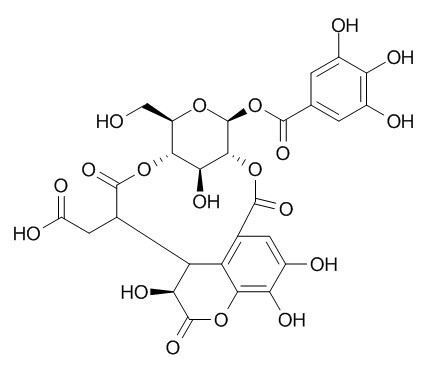Chebulanin
Chebulanin is a topoisomerase I inhibitor, it inhibits the calcineurin pathway in C. neoformans. Chebulanin exhibits potent antifungal activity against various human pathogenic fungi with minimum inhibitory concentrations ranging from 0.25 to over 64 μg/ml. Chebulanin shows strong radical scavenging activity, good potency to chelate Fe2⁺ and good inhibition ability of lipid peroxidation. Chebulanin is a strong therapeutic alternative for the treatment of rheumatism arthritis, it suppresses the expression of inflammatory mediators and prevents cartilage destruction and bone erosion in mice.Chebulanin has anti-cancer acrtivity, it has apparent capacities of inhibiting the survival of MCF-7 human cancer cell line.
Inquire / Order:
manager@chemfaces.com
Technical Inquiries:
service@chemfaces.com
Tel:
+86-27-84237783
Fax:
+86-27-84254680
Address:
1 Building, No. 83, CheCheng Rd., Wuhan Economic and Technological Development Zone, Wuhan, Hubei 430056, PRC
Providing storage is as stated on the product vial and the vial is kept tightly sealed, the product can be stored for up to
24 months(2-8C).
Wherever possible, you should prepare and use solutions on the same day. However, if you need to make up stock solutions in advance, we recommend that you store the solution as aliquots in tightly sealed vials at -20C. Generally, these will be useable for up to two weeks. Before use, and prior to opening the vial we recommend that you allow your product to equilibrate to room temperature for at least 1 hour.
Need more advice on solubility, usage and handling? Please email to: service@chemfaces.com
The packaging of the product may have turned upside down during transportation, resulting in the natural compounds adhering to the neck or cap of the vial. take the vial out of its packaging and gently shake to let the compounds fall to the bottom of the vial. for liquid products, centrifuge at 200-500 RPM to gather the liquid at the bottom of the vial. try to avoid loss or contamination during handling.
Pest Manag Sci.2023, 79(8):2675-2685.
Evid Based Complement Alternat Med.2015, 2015:165457
Nutr Cancer.2023, 75(1):376-387.
University of East Anglia2023, 93969.
Int J Mol Sci.2023, 24(8):7045.
J of Applied Biological Chem.2020, 63(2):147-152
Food Chem X.2024, 21:101127.
Asian Pac J Cancer Prev.2021, 22(S1):97-106.
Molecules.2018, 23(2)
Planta Med.2016, 82(13):1208-16
Related and Featured Products
Food Chemistry, 2011 , 126 (1) :277-282.
Antioxidant and antiproliferative capacities of phenolics purified from Phyllanthus emblica L. fruit[Reference:
WebLink]
Phyllanthus emblica is a widely distributed tropical medicinal plant with good therapeutic properties.
METHODS AND RESULTS:
Gallic acid, ellagic acid, mucic acid 1,4-lactone 3-O-gallate, isocorilagin, Chebulanin, chebulagic acid and mallotusinin were isolated and purified from this plant. The antioxidant activities of these compounds were evaluated by in vitro models of scavenging superoxide anion radicals, DPPH radicals and ABTS radicals, chelating ability of ferrous ion and inhibition capability of Fe (II)-induced lipid peroxidation, respectively. The results revealed that all the tested phenolics showed strong radical scavenging activity, good potency to chelate Fe2+ and good inhibition ability of lipid peroxidation. Amongst mallotusinin and mucic acid 1,4-lactone 3-O-gallate were reported for the first time to have antioxidant activity. In addition, the in vitro antiproliferative activities of those phenolics against MCF-7 breast cancer cell lines were assessed.
CONCLUSIONS:
Although the growth inhibition values induced by different phenolics on MCF-7 cell line yielded different effects, all the tested phenolics had apparent capacities of inhibiting the survival of MCF-7 human cancer cell line.
PLoS One. 2015 Sep 24;10(9):e0139052.
Anti-Arthritic Effect of Chebulanin on Collagen-Induced Arthritis in Mice.[Pubmed:
26402786 ]
Rheumatoid arthritis is a chronic degenerative autoimmune disease characterized by persistent inflammation of synovial membranes, which leads to cartilage destruction and bone erosion. To date, there are no effective therapies to slow the progress of this degenerative condition.
METHODS AND RESULTS:
Here, we evaluate the anti-arthritic effect of Chebulanin, an abundant anti-inflammatory agent isolated from Terminalia chebula, in collagen induced arthritis in DBA/1 mice by intragastric administration. Arthritic severity was scored by performing histopathological evaluation of the joints and measuring the expression of inflammatory cytokines and relative enzymes by immunohistochemical staining. In parallel, bone destruction and erosion were confirmed by micro-CT. Our data revealed that Chebulanin significantly improved the severity of arthritis. Specifically, the histopathological characteristics of the tissues were improved and expression of TNF-α, IL-6, MMP-3 and COX-2 in the paws and joints of the treated mice decreased in a dose-dependent manner compared with control mice. Furthermore, micro-CT analysis revealed that Chebulanin induced a dose-dependent reduction in cartilage destruction and bone erosion.
CONCLUSIONS:
Taken together, our findings suggest that Chebulanin suppresses the expression of inflammatory mediators and prevents cartilage destruction and bone erosion in mice. Therefore, Chebulanin is a strong therapeutic alternative for the treatment of RA.
J Microbiol Biotechnol. 2014 Oct;24(10):1377-81.
Inhibition of the calcineurin pathway by two tannins, chebulagic acid and chebulanin, isolated from Harrisonia abyssinica Oliv.[Pubmed:
25001554]
METHODS AND RESULTS:
In order to discover and develop novel signaling inhibitors from plants, a screening system was established targeting the two-component system of Cryptococcus neoformans by using the wild type and a calcineurin mutant of C. neoformans, based on the counter-regulatory action of high-osmolarity glycerol (Hog1) mitogen-activated protein kinase and the calcineurin pathways in C. neoformans. Among 10,000 plant extracts, that from Harrisonia abyssinica Oliv. exhibited the most potent inhibitory activity against C. neoformans var. grubii H99 with fludioxonil. Bioassay-guided fractionation was used to isolate two bioactive compounds from H. abyssinica, and these compounds were identified as chebulagic acid and Chebulanin using spectroscopic methods.
CONCLUSIONS:
These compounds specifically inhibited the calcineurin pathway in C. neoformans. Moreover, they exhibited potent antifungal activities against various human pathogenic fungi with minimum inhibitory concentrations ranging from 0.25 to over 64 µg/ml.



